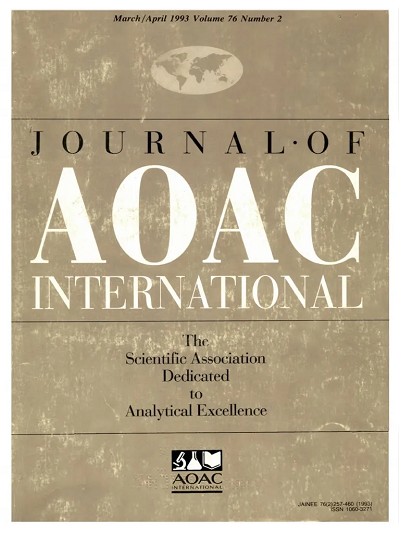评估利用紫外线吸收率区分湿润与非湿润材料的方法
IF 1.7
4区 农林科学
Q3 CHEMISTRY, ANALYTICAL
引用次数: 0
摘要
背景 含腐植酸(HA)和富里酸(FA)的产品具有巨大的商业潜力,然而,消费者并不知道,有些产品可能贴错标签或含有掺假物。贴错标签和掺假的情况主要出现在富里酸产品中。使用紫外可见光谱来区分真假 FA 产品既实用又可取。本研究的目的是扩大使用 Mayhew 等人 2023 年提出的基于紫外可见光谱的方法生成的数据集。方法 使用 Mayhew 等人,2023 年提出的紫外-可见光方法(在本研究中称为 UVAC(紫外吸光度确认)方法),总共使用了三十(30)个测试样本来生成九十个测试部分(每个测试样本 3 个重复)进行分析。结果 在所调查的 13 个 FA 测试样品中,没有一个样品被确定为使用紫外吸光度确认法进行的腐殖化。所研究的 FA 样品包括两种 IHSS 标准、五种商业 FA 产品 (CFAP) 和六种全 FA 馏分 (SFA),它们是从六种已知的固体腐殖质材料来源 (SHMS) 中分离出来的。其中有一种柠檬岩、一种腐植岩和四种泥炭来源被用作 SHMS。对 SHMS 的中和提取物进行分析后发现,只有 3/6 的 SHMS 被确定为腐殖质。通过分离 SHMS 中的 HA,还生成了 6 个 HA(SHA)测试样本,结果只有 3/6 的 SHA 被确定为腐殖化。结论 鉴于错误测定的发生率较高,需要进一步改进该方法,以便供行业或监管机构使用。要点 建议的方法未能确定 IHSS FA 标准为腐殖化。虽然该方法很实用,但还需要改进和进一步研究,才能用于可靠地区分真假 FA 或 HA。本文章由计算机程序翻译,如有差异,请以英文原文为准。
Evaluating the use of UV Absorbance for the Differentiation of Humified from Non-humified Materials
Background Products containing humic acids (HA) and fulvic acids (FA) have significant commercial potential, however, unknown to the consumer, some products may be mislabeled or contain adulterants. The prevalence of mislabelling and adulterants is primarily found in FA products. Using UV-Vis spectroscopy to differentiate between real and fake FA products is practical and desirable. Objective The objective of this study was to expand the data set generated using a UV-VIS based method proposed by Mayhew et al., 2023. Methods In total, thirty (30) test samples were used to generate ninety test portions (3 replicates per test sample) for analysis using the UV-Vis methodology outlined in Mayhew et al., 2023, which in this study is referred to as the UVAC (UV absorbance confirmation) method. Results None of the thirteen FA test samples investigated were determined as humified using the UVAC method. The FA samples studied comprised of two IHSS standards, five commercial FA products (CFAP) and six full FA fractions (SFA), which were isolated from six known solid humic material sources (SHMS). There was a leonardite, a humalite, and four peat sources used as the SHMS. Analysis of the neutralized extract of the SHMS found only 3/6 SHMS were determined as humified. Six HA (SHA) test samples were also generated by isolating the HA from the SHMS and only 3/6 SHA were determined as humified. Conclusion Given the high prevalence of false determinations more work is needed to improve the method so it can be used by industry or regulators. Highlights The proposed method failed to determine IHSS FA standards as humified. Although the method is practical, it needs improvement and further study before it can be used for reliable differentiation of real from fake FA or HA.
求助全文
通过发布文献求助,成功后即可免费获取论文全文。
去求助
来源期刊

Journal of AOAC International
医学-分析化学
CiteScore
3.10
自引率
12.50%
发文量
144
审稿时长
2.7 months
期刊介绍:
The Journal of AOAC INTERNATIONAL publishes the latest in basic and applied research in analytical sciences related to foods, drugs, agriculture, the environment, and more. The Journal is the method researchers'' forum for exchanging information and keeping informed of new technology and techniques pertinent to regulatory agencies and regulated industries.
 求助内容:
求助内容: 应助结果提醒方式:
应助结果提醒方式:


